#Carrots Bell Peppers Recipe
Explore tagged Tumblr posts
Text


Beef Stir Fry With Noodles
#Stir Fry#noodles#broccoli#baby corn#mushrooms#red bell pepper#carrot#recipe#food#food blog#recipes#delicious#yummy food#beef
917 notes
·
View notes
Text

Super crunch salad
#salad#healthy food#carrot#vegetables#food#meal#veggies#lunch#dinner#side dish#cabbage#bell peppers#corn#tasty#foodporn#delicious#cooking#food photography#foodgasm#recipes
296 notes
·
View notes
Text

Ground Beef Noodle Stir Fry
#food#recipe#dinner#stir fry#beef#noodles#ramen noodles#bell pepper#peppers#onions#carrots#cabbage#mushrooms#ginger#garlic#honey#oyster sauce
110 notes
·
View notes
Text

I made some Tofu stir-fry for my mom (She’s too been a vegetarian for many years).
#food#tofu recipes#tofu#stir fry#delicious#garlic#homecooking#vegan#veganfood#vegetarian#vegetables#sriracha#kung pao#soy sauce#bell peppers#fried rice#carrots#Chinese dish#chinese food#one pan#tempeh#today's lunch
9 notes
·
View notes
Text
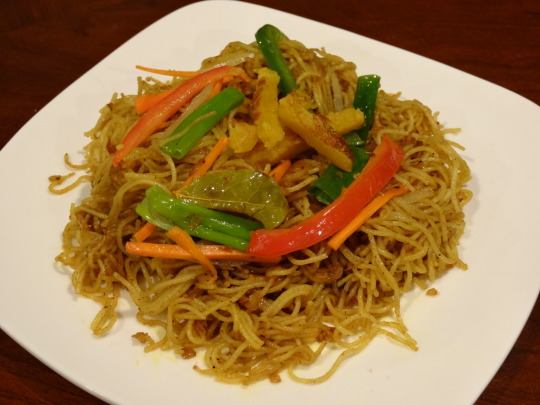
星洲炒米粉 / Xing zhou chao mei fun (Singapore noodles)
This dish fries steamed noodles and assorted vegetables in a mildly spicy curry paste, made from a bespoke curry powder and a blend of fresh aromatics. The result is a crispy, chewy, complex, warming stir-fry with notes of turmeric, liquorice root, and cinnamon.
Though this dish is referred to as "Singapore noodles," vermicelli dishes common in Singapore do not include curry powder! These "Singapore" noodles in fact originated in Hong Kong 茶餐廳 (cha chaan teng; Western-influenced cafés), and gained popularity between the 1940s and 60s. They combine British influence (in the form of curry powder) with the rice noodles common in Chinese, Malay, and Indian cooking; the reference to Singapore is perhaps a nod to the cosmopolitan, "exotic" atmosphere of these cafés.
This is a vegan version of a dish that often also includes shrimp, char siu, or chicken. Instructions for a vegan version of the typical sliced fried egg topping are included.
Recipe under the cut!
Patreon | Tip jar
Serves 3-4.
Ingredients:
For the dish:
200g vermicelli rice noodles (bee hoon / mi fen; 米粉)
4 green onions, greens and whites separated
1/2 medium yellow onion, thinly sliced
1 medium (50g) julienned red mild chili (such as aji dulce), or 1/4 medium red bell pepper
1 medium (50g) julienned green mild chili, or 1/4 medium green bell pepper
1 bunch yellow chives
Small handful bean sprouts
3-inch piece (40g) carrot, julienned
1 tsp table salt, or to taste
Large pinch MSG (optional)
Rice vermicelli (also known as bee hoon / bihun, mee hoon / mihun, or mi fen) are long, fine rice noodles. They should not be confused with semolina vermicelli. They may be purchased at an east or southeast Asian grocery store; Chinese, Vietnamese, or Thai rice vermicelli will all work. I used Hai Ca Vang rice vermicelli, which I like in this dish for how well they stand up to stir-frying, and the chewy bite they give to the final dish.
Yellow chives are simply chives that have less color because they are grown out of the sun. They may be found in a Chinese grocery store; if you can't get your hands on any, omit them or substitute more bean sprouts.
For the curry paste:
4 tsp curry powder Singapura, or to taste
3 cloves garlic
4 Thai shallots, or 1 Western shallot
1-inch chunk (10g) ginger
1/4 medium yellow onion
White of 1 stalk lemongrass (optional)
1 bay leaf (optional)
Some versions of Singapore noodles are flavored entirely with curry powder, or (if a spicier curry powder is being used) with a mix of curry powder and turmeric; home cooks tend to include less curry powder or paste than restaurants do. You could decrease the amount of curry powder down to about a teaspoon for a home cook version of this dish. If you aren't making your own, Singapore curry powder (咖哩粉) can be purchased online from specialty spice retailers, or from a Hong Kongese brand such as Koon Yick Wah Kee; you could also substitute another mild, sweet curry powder, such as Japanese curry powder (S&B is a popular brand).
You could skip prepping the aromatics as well by purchasing a jar of ready-made Chinese curry paste (咖哩醬) from a brand such as Koon Yick Wah Kee (whose blend consists of curry powder hydrated with white vinegar and soybean oil); Malaysian curry paste would be a good substitute. Some recipes make a quick homemade curry paste by combining curry powder with salt (1 tsp), sugar (1 tsp), oyster sauce (1 Tbsp), water (2 Tbsp), and sometimes chili sauce, and add this sauce to the noodles as they are fried. I prefer versions of the dish that add fresh aromatics, though—I think they round out the curry powder by providing a flavorful base for it. You can experiment until you get the flavor and texture you prefer.
For the egg:
1/4 cup (60mL) coconut milk, or water
1/2 tsp ground turmeric
1/4 - 1/3 tsp kala namak (black salt)
1/4 tsp ground white pepper (optional)
1/2 tsp Liaojiu (Chinese cooking wine)
Liaojiu will likely be labelled "Shaoxing wine" in English. For an alcohol-free version, use ume plum vinegar or apple cider vinegar. The wine is used to flavor and cut the 'egginess' of the eggs.
This recipe usually calls for eggs, liaojiu, and salt. The turmeric and white pepper add flavor and color; the kala namak provides an eggy taste.
Instructions:
1. Prepare the aromatics. Peel and chop the garlic; mince the onion and shallots; scrub and mince the ginger (there's no need to peel it). Divide the whites of the green onions from the greens, and mince the whites.
Pull away any tough outer leaves of lemongrass. Separate the yellow / white section from the green, and cut off the root end. Reserve the green to flavor soup stocks. Thinly slice the white of the lemongrass widthwise, then pass the knife through for another few minutes to mince very thoroughly.


For a "saucier" noodle dish, pulverize the aromatics in a mortar and pestle or a blender rather than mincing them.
2. Prepare the vegetables. Cut peppers into a thin julienne; julienne the carrots; thinly slice the onion. Cut the greens of green onions, bean sprouts, and chives into 1 1/2 or 2” pieces.
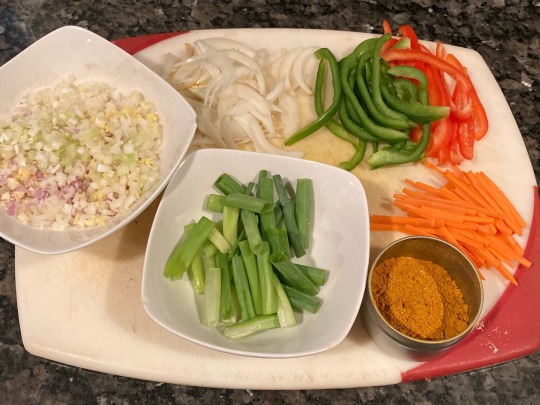
3. Cook the noodles. Soak noodles in just-boiled water for about 90 seconds, or until they break when pinched firmly. Depending on the thickness of your noodles, they may need as much as 2-3 minutes.
Drain the noodles, but don’t rinse them. Spread them out on a baking sheet and cover to allow to steam for 10 minutes. With oiled hands, gently pull apart and untangle the noodles. Cut them in a few places with kitchen scissors to make stir-frying easier.
4. Cook the egg garnish. Whisk all ingredients for the egg together in a small bowl. Heat a wok over medium heat for several minutes, then add in a couple teaspoons of oil and swirl to coat the surface of the wok. Pour ‘egg’ into the bottom of the wok, then lower heat to low and allow to cook until darkened and solidified on top. Flip and cook the other side on medium-high until browned in places. Remove from wok and thinly slice.
5. Cook the vegetables. Heat wok on high for several minutes. Add in a couple teaspoons of oil and swirl to coat. Fry sliced onions, agitating often, for about 30 seconds; add carrots and fry another 30 seconds. Add peppers and cook for another 20-30 seconds. Remove from wok.
Cook chives or bean sprouts for 30 seconds to a minute, until slightly wilted, and remove.
6. Make the curry paste. Add another couple teaspoons of oil to the wok. Fry the aromatics (whether minced or pulverized) and bay leaf, stirring often, until fragrant, about 2 minutes. Lower heat to low, then add the curry powder and stir. Immediately add another couple teaspoons of oil, or enough to create a bit of sauce (the amount will vary based on how much curry powder you've added).
If you're using pre-made curry paste, just fry it for 30 seconds or a minute until fragrant. If you're using a mix of vegetarian oyster sauce, water, salt, and sugar, skip this step.
7. Fry the noodles. Raise the heat to medium-high. Add the noodles and stir to coat evenly. Allow noodles to sit for a minute or two, then flip with chopsticks or tongs and allow to fry again. This will help the noodles to fry and brown.
Do this a few times until noodles are evenly toasted, 4-5 minutes. Add salt and MSG (or oyster sauce mixture) and stir to coat. Add in vegetables, egg, and green onions and cook for another minute until green onions are wilted.
65 notes
·
View notes
Text

солёные помидоры (Russian Pickled Tomatoes)
#солёные помидоры#russian food#pickled tomatoes#pickled vegetables#russian pickled tomatoes#vegetarian#ukranian food#tomatoes#dill#dill flowers#cilantro#horseradish leaves#black currant leaves#garlic#peppercorns#bay leaves#carrots#chili peppers#paprika#bell peppers#water#salt#sugar#white vinegar#recipes
3 notes
·
View notes
Text

Maangchi's Japchae Recipe
#food#recipe#korean#asian#beef#steak#bell pepper#carrot#onion#spinach#noodles#japchae#sesame#sesame oil#comfort food
14 notes
·
View notes
Text

Teriyaki Tempeh Stir Fry
#veganonboard#stir fry#dinner#savoury#tempeh#food#recipe#recipes#vegan#veganism#vegetarian#carrot#carrots#capsicum#broccolini#peppers#bell peppers#pepper#bell pepper#nutrition#fitspo#fitblr#fitness#fitspiration#diet#weightloss#weight loss#gym#gymlife#gymmotivation
4 notes
·
View notes
Photo

Israeli Moroccan Couscous - Everyday Cooking Carrots, turnips, sweet potatoes, zucchini and red bell pepper are simmered with garbanzo beans and tomato sauce, and flavored with cinnamon, turmeric and curry. This beautiful, tasty concoction is served atop hot couscous.
0 notes
Photo

Stuffed - Chicken Wild Rice Stuffed Red Peppers Recipe Red bell peppers are stuffed with a creamy chicken and wild rice filling perfect for weeknights or dinner parties.
0 notes
Text
#spinach#potatoes#sweet potatoes#bell peppers#salt#olive oil#carrots#tomatoes#tomato#black pepper#chicken soup#brain soup#recipe#pasta#bread#meatballs#soup speaks#soup#souplovers#cheese
1 note
·
View note
Text


Salmon Stir Fry
#salmon#stir fry#broccoli#carrots#ginger#green onion#red bell pepper#snap peas#recipe#food#food blog#recipes#delicious#yummy food
86 notes
·
View notes
Text
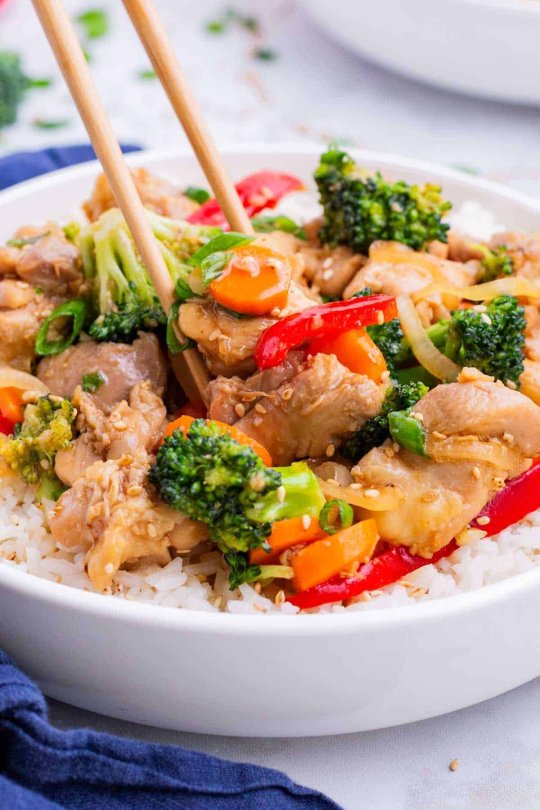
Honey garlic chicken stir fry
#chicken#stir fry#chicken stir fry#dinner#food#asian food#vegetables#broccoli#bell pepper#carrots#garlic#rice#main course#tasty#foodporn#delicious#cooking#food photography#foodgasm#recipe
228 notes
·
View notes
Text

Veggie Summer Rolls with Creamy Peanut Butter Sauce
#food#recipe#appetizer#spring rolls#peanut butter#peanut#dip#vermicelli#noodles#cilantro#carrots#cabbage#avocado#lettuce#bell pepper#peppers#spinach#lemon#vegetarian#vegan#dairy free
61 notes
·
View notes
Photo
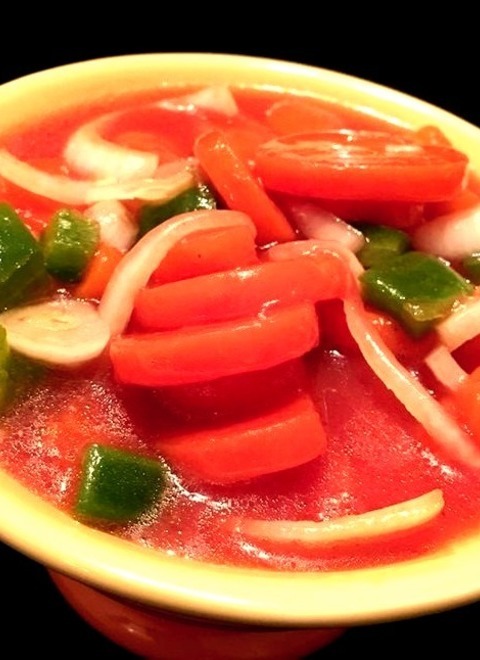
Easy Marinated Carrots Recipe This is a great vinaigrette recipe for carrots using tomato soup, sugar, and vinegar. 1 onion chopped, 1/2 cup vegetable oil, 1 cup white sugar, 1/4 teaspoon ground black pepper, 1 teaspoon Worcestershire sauce, 3/4 cup white vinegar, 1 can condensed tomato soup, 1 teaspoon dry mustard, 1 green bell pepper chopped, 2 pounds carrots sliced, 1/4 teaspoon salt
0 notes
Text
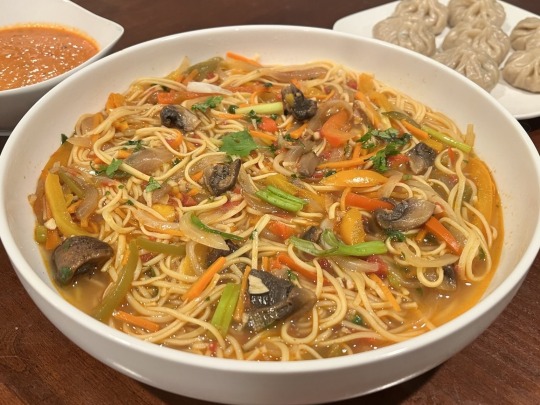
[ID: A large, shallow bowl filled with soup with orange broth, noodles, mushrooms, and bell peppers, garnished with green onion and cilantro. A plate of dumplings and a bowl of sauce are visible in the background. End ID.]
Thukpa / थुक्पा (Nepali noodle soup)
Thukpa is a Himalayan noodle soup that originated in Tibet before becoming popular in Nepal, Butan, and northeast India, where many different varieties of it are eaten in the home and as a street food. This Nepali-style version is flavored with green chilis, cumin, coriander, and ginger, and brightened with the addition of fresh herbs and lime juice. This is a warming, filling, one-pot meal, perfect for winter!
Recipe under the cut.
Patreon | Tip jar
Serves 8-10.
Ingredients:
1/2 each green, yellow, and red bell pepper, sliced
1 green hot chili pepper, slit
4 green onions, cut into 2-inch pieces
2-inch chunk ginger, minced
4 cloves garlic, minced
1 Tbsp cumin seeds, toasted and ground
1 Tbsp coriander seeds, toasted and ground
1 large or 2 small roma tomatoes, diced (150g)
250g dried thukpa noodles or Chinese wheat noodles
1/2 cup shredded cabbage
1 cup quartered button mushrooms
1 large carrot, julienned
8 cups (2L) water
1 Tbsp vegetarian chicken stock from concentrate, or 2 vegetarian chicken-flavored stock cubes (optional)
Juice of 1 lemon or lime
Bunch of garlic greens, or fresh cilantro, chopped
1 Tbsp soy sauce (optional)
Salt to taste (about 2 tsp, less if you used a stock cube containing salt)
1/2 tsp chaat masala or garam masala (optional)
Mustard oil is typically used for this soup, but you can also use any neutral oil.
Nepali thukpa noodles may be found at an Asian grocery store or purchased online. They may be labeled "Thukpa noodles" or "Himalayan noodles." Any thin wheat noodle may be used as a substitute.
Thukpa also commonly includes chicken. I have omitted it and focused on the veggies in this recipe (a lot of Nepali thukpa recipes are vegetarian!), but if you have a chicken substitute onhand you can cook it in the oil at the beginning of step 2, then remove it from the pot; return it to the soup when ready to serve.
Chickpeas, split bengal gram, or other beans are sometimes added to vegetarian versions of Nepali thukpa for protein. Add in cooked beans or grams at step 7.
Chicken stock is not usually used in this soup. I like to use a vegetarian chicken stock cube in my version to simulate the effect of boiling chicken in the soup water along with the vegetables; I think it adds a nice savor.
Instructions:
1. Boil noodles according to package directions, until they are al dente (use salted water if the noodles themselves do not contain salt). Drain noodles and rinse with cold water to halt cooking.
2. In a large pot, heat oil on medium until shimmering. Add onion and saute, agitating occasionally, 3-5 minutes until translucent. Add ginger, garlic, and green chili and fry for 30 seconds until fragrant and no longer raw-smelling.
3. Meanwhile, add half of ground coriander and cumin to a small bowl and add just enough water to form a thick paste. When garlic and ginger are fragrant, add the spice paste to the pot and cook, stirring often, until the water has evaporated to bloom the spices.
4. Add tomatoes and cook, covered, for 2 minutes until soft. Mash with the flat of a ladle.
5. Add mushrooms, carrots, cabbage, and bell peppers. Cook, uncovered, on medium low for 3 minutes, then cover and cook for another 3 minutes.
6. Add the rest of the ground coriander and cumin and stir to combine.
7. Add water (and chicken stock concentrate or cubes, if using) and bring to a boil. Cook for a few minutes until vegetables are tender and cooked through.
8. Add chaat masala or garam masala and simmer another minute.
9. Reduce heat to low. Add green onion, garlic greens, lime juice, and soy sauce and simmer for another minute.
10. Add cooked noodles (and chicken, if using) and heat until warmed through. Taste and add salt if necessary. Serve hot.
#one pot#vegetarian recipes#recipe#one pot recipes#Nepali#cooking#under an hour#bell peppers#mushrooms#green onion#tomatoes#noodles#cabbage#carrots
135 notes
·
View notes